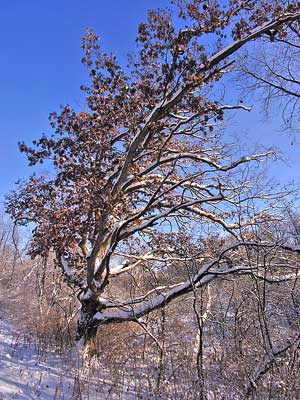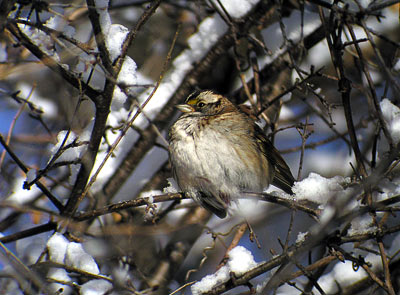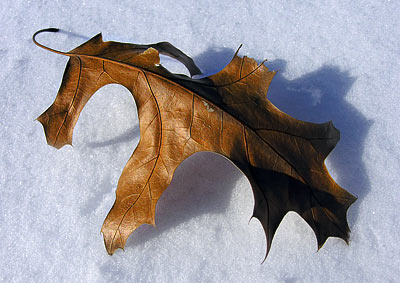Thursday, December 25, 2008
Path
It was -2 degrees Fahrenheight when I hit the trail at Pheasant Branch Conservancy this morning with my snowshoes, but the skies were blue. Almost worse than digiscoping under overcast conditions is the bitter cold - I find it very difficult to get a sharp image and my camera's batteries have a tendency lose their charge far more quickly. Would I trade these frigid conditions for mosquitoes? I don't know. I honestly don't know. There were plenty of birds around, but a White-throated Sparrow trying to keep warm was my sole digiscoped subject:
Doesn't look too thrilled, eh? There were other scenic things to photograph, like oak trees with branches thickly frosted with fresh snow. Sometimes I liken my nature excursions to an Edward Abbey quote I saw on Doc Ern's blog:
"Our job is to record, each in [her/his] own way, this Earth of light and shadow and time that will never come again exactly as it is today."
Yeah, that's been my job here, but it's not without criticism. "All he does is talk about his birds." "All he ever does is play with his birds." "You're a little geek with your birds. That's how I see you." If one were to witness the emotion behind this ranking, it might accurate to assume I possess a rather shallow mind with diminutive boundaries - a dullard. I do I spend an inordinate amount of time observing, photographing, and reading about birds. But such criticism lacks circumspection. Oh sure, holding binoculars up to a bird and marveling at its beauty in absolute transcendence is the apex of this recreation, but there's a lot more bird to this beak. Even the novice birder soon realizes there's a plethora of attainable knowledge as well as mystery glued to what is fundamentally an aesthetic fixation.
So, what are a few inherent scientific disciplines? Birds fly: aerodynamics. They have hollow bones: anatomy. They can be hierarchically classified: taxonomy and cladistics. They'll cross continents during migration: geography. They sing: acoustics. They've changed over time: paleontology, natural history and biological evolution. Seasonal timing with respect to the availability of food items: phenology. During migration, birds can detect the circumpolar movement of stars: astronomy. Weather systems affect bird behavior during migration: meteorology. You get the idea, but why not go on? Habitat requirements: ecology and climatology. From that vein, we can branch to a heightened awareness for the environment, which will often bridge to politics. Then there are all the interesting social interactions and behavioral bits involving bird and birder: ethics, psychology and sociology. You can volunteer to restore a prairie, have empathy for an injured bird and be charitable by donating money to a rehabilitator, or perhaps stop someone from harming a bird: morality. You can lead a field trip and teach others some of the above: education.
Even this barely scratches the surface. Birding needn't encompass multidisciplinary study and understanding to be thoroughly enjoyed, but many will do so unintentionally. Aware or not, the birder slowly becomes a naturalist. Bird density and diversity means accessibility. For the astute observer, birding increases one's awareness on how things work in nature and recognizes the same forces, rules and processes in play throughout the animal kingdom, across the entire globe. As a finite being, to develop and form an understanding of how I fit into nature's realm happens to be the most compelling and philosophically profound thing I can think of doing with my brief time here.
All images © 2008 Mike McDowell




















